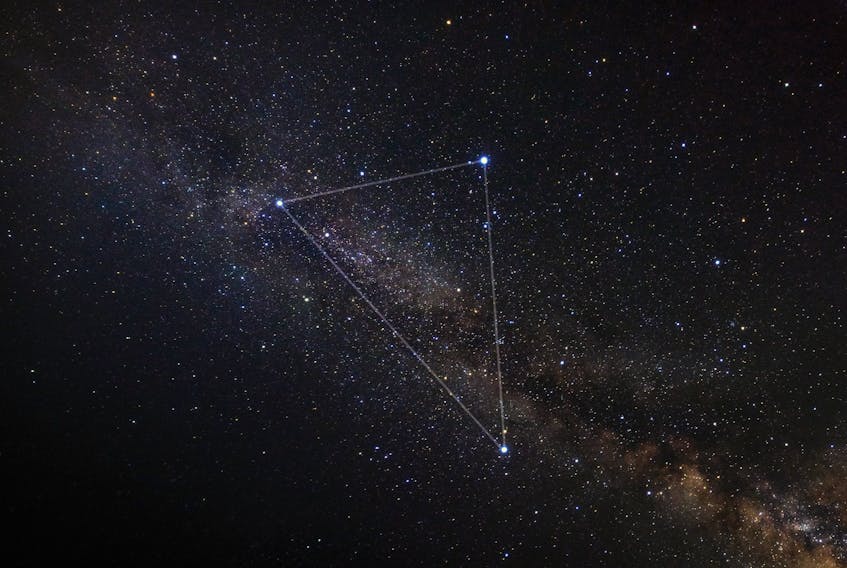The Summer Triangle is prominent in the eastern evening sky as darkness falls around 10 p.m.
The triangle itself is composed of three bright stars from three different constellations. Two of the three constellations are avian in nature: Cygnus - the Swan, and Aquila - the Eagle.
In Greek mythology, the constellation of Cygnus (from the Latinized Greek meaning "swan") has its roots in two possible representations. It could represent Zeus, in the form he took when he seduced the Spartan queen Leda (thus the 'Leda and the Swan' story), the union that produced the Gemini twins, Castor and Pollux, plus Helen (the same woman over whom the Trojan War was said to have been fought). Or, it could represent the legendary Greek musician and poet, Orpheus, who was transformed into a swan by the gods after his murder at the hands of the Maenads (female worshipers of Dionysus, Greek god of wine, fertility and religious ecstacy). The gods placed Orpheus in the heavens next to his beloved musical instrument, the lyre (harp), in the night sky (Lyra - the Lyre).
It is thought, too, that this constellation may have been associated with Phaeton, the son of Helios, god of the sun, who lost control of his father's golden chariot (symbolic of the sun) as he drove it across the sky one day, and was brought down by one of Zeus' thunderbolts, falling and drowning in the ocean below. His friend, Cycnus (another spelling of Cygnus), the son of Aries, the Greek god of war, spent countless days diving into the ocean to recover the remains of Phaeton to give him a proper burial. As a reward for such devotion, the gods reputedly placed Cycnus in the sky after his death.
The "swan" shape is formed by Deneb (a white supergiant, magnitude +1.2, approximately 3,200 light years away) which serves as the swan's "tail"; Sadr (magnitude 2.2, 1,500 light years) as the "breast" of the swan; Epsilon Cygni (a multi-star system, magnitude +2.5, 73 light years) and Delta Cygni (a triple-star system, magnitude +5.1, 415 light years) as the two wingtips; and Albireo (an orange and blue-green binary star system, magnitude +3.0, 415 light years) forming the swan's "beak".
Within the constellation of the swan lies the famous and easily identified "Northern Cross" asterism.
Aquila - the Eagle is said to represent the huge royal eagle that carried the thunderbolts of Zeus/Jupiter in Greek-Roman mythology. It was this eagle that, by Zeus' decree, kidnapped the young Trojan prince, Ganymede, to serve as the cup-bearer of the gods on Mount Olympus.
The constellation's primary star, Altair (from the Arabic phrase al-nasr al tair - meaning "the flying eagle"), is the twelfth brightest star (magnitude +0.77) in the night sky, and, at only 17 light years away, it is the closest naked-eye star to Earth. There's some thought that this constellation was based on an ancient Babylionian constellation of an eagle, located in the same area as the Greek constellation. The Romans knew this constellation as Vultur volans (meaning "flying vulture").
This week's sky
Heading towards inferior solar conjunction (passing in front of the sun) on June 30, Mercury is currently too close to the sun to be seen. Jupiter (magnitude -2.7) will be visible around 11 p.m. at about eight degrees (a little less than a hand's width at arm's length) in the southeastern night sky, disappearing in the south-west, pre-dawn sky around 5 a.m.
Saturn (magnitude +0.3) appears nine degrees above the southeastern horizon around 11:30 p.m., before being lost in the south-west sky in dawn twilight about 4:45 a.m.
Mars (magnitude -0.4) rises in the south-east night sky just before 1 a.m., fading from view high in the pre-dawn, southern sky by 5 a.m.
Venus shines brilliantly at magnitude -4.3 as it rises in the east around 3:40 a.m., reaching 12 degrees high in the pre-dawn sky before fading from view around 5 a.m.
The Full Moon on July 5 is often referred to by a number of names - the "Buck Moon" (this is the time of year when the buck deer start growing their new antlers); the "Thunder Moon" (for the summer thunderstorms)' and the "Hay Moon" (farmers usually get their first crop of hay in at this time).
Until next week, clear skies.
Events
June 29 - Moon at perigee (closest to Earth)
June 30 - Mercury at inferior solar conjunction
July 5 - Full moon
Glenn K. Roberts lives in Stratford, P.E.I., and has been an avid amateur astronomer since he was a small child. He welcomes comments from readers, and anyone who would like to do so is encouraged to email him at [email protected].









